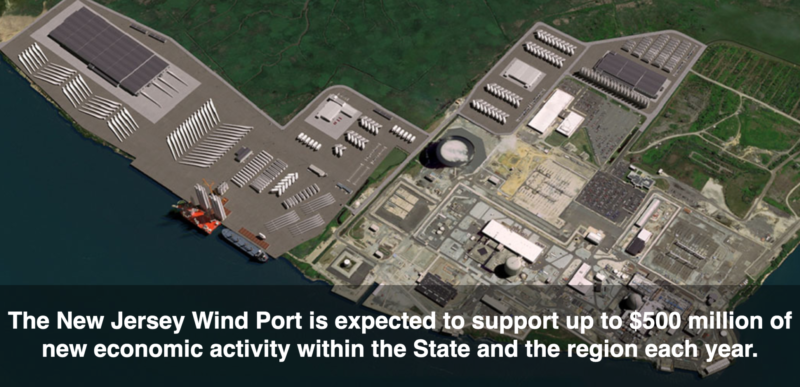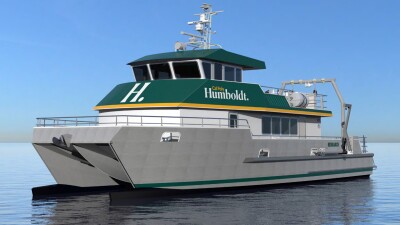New Jersey Gov. Phil Murphy says the state will develop a dedicated offshore wind energy port on the lower Delaware River, spending up to $400 million to support the state’s ambitious goal of developing 7,500 megawatts of wind power capacity by 2035.
Located adjacent to the Hope Creek nuclear power station in Lower Alloways Creek Township in rural Salem County, the site of 200-plus acres is close to the deep-draft ship channel from Philadelphia to Delaware Bay and the Atlantic – and downstream from highway bridges over the river. That eliminates the constraints of air draft at other East Coast ports like New York, where even bridge clearances of 200 feet will not be enough to accommodate the size of next-generation turbine components carried on barges and installation vessels.
“Offshore wind is a once-in-a-generation opportunity to not only protect our environment but also greatly expand our state economy in a way that has immediate impacts and paves the way for long-term growth,” Murphy said Tuesday in announcing the site selection. “The New Jersey Wind Port will create thousands of high-quality jobs, bring millions of investment dollars to our state, and establish New Jersey as the national capital of offshore wind.”
Murphy’s announcement came at a pivotal moment for U.S. offshore wind, days after the federal Bureau of Ocean Energy Management released a supplemental draft environmental impact statement that looks at cumulative impacts of more than a dozen proposed turbine arrays off the East Coast.
That document acknowledges the new industry will have major impacts on the commercial fishing industry. “Our goal is that all users can successfully coexist,” BOEM Acting Director Walter Cruickshank said of his agency’s ongoing review.
A 22-month selection process led to the New Jersey site on Artificial Island, owned by power company PSEG which has operated a nearby trio of nuclear reactors for decades. PSEG is now investing in relationships with offshore wind energy developers – including New Jersey’s first project, the 1,100 MW Ocean Wind development to be built by Ørsted. That plan would bring its power cables ashore at the now-decommissioned Oyster Creek nuclear station on the state’s Atlantic coast.
The legacy of nuclear power at Artificial Island includes a substantial road network able to handle heavy industrial truck traffic and highway access for bringing in material and components. Dredging and new berths would accommodate installation vessels and barges to transport everything out to the construction sites on federal leases offshore.
The wind port construction is planned in two phases, beginning in 2021 and first operations in 2023. Phase 1 calls for developing a 30-acre site to accommodate marshalling activities and a 25-acre component manufacturing site. As offshore activity grows with other projects, a Phase 2 would add more than 150 acres to accommodate expanded marshaling activities, plus manufacturing facilities for turbine components like blades and nacelles – a key long-range goal to build most components on U.S. soil.
State officials peg the costs between $300 million and $400 million when fully built out, and the state Economic Development Authority is looking at a range of public, private, and public-private partnership financing options.
The Murphy administration touts a potential for up to 1,500 manufacturing, assembly, and operations jobs and hundreds of construction jobs to be generated by the port, and pledges to use union labor in construction – a critical political constituency in New Jersey and other Northeast states where Democratic governors are pushing wind energy as an economic stimulus.
“The New Jersey Wind Port will be an incredible project that benefits the entire state, but it will be particularly important for South Jersey,” said Democratic state Senate President Steve Sweeney, who has strong union ties. “Creating thousands of jobs in a region that has been overlooked in the past is crucial to addressing our current economic challenges and laying the foundation for future economic growth.”
About 35 miles north – and upriver of two bridge crossings – the port of Paulsboro, N.J., has been proposed earlier as a wind energy support base. Despite $225 million in new investment, that port has not attracted the new shipping traffic and onshore jobs hoped for. The Artificial Island proposal is very focused on the demands of an evolving U.S. wind industry, and much larger turbine systems now in development.
Studies by wind developers, industry advocates, independent analysts, the U.S. Department of Energy and others have all stressed the need for new port facilities designed specifically to meet the offshore wind industry’s unique needs. As of now, there is no East Coast equivalent to large terminals in northern Europe that serve that continent’s wind industry.
Wind turbines are partially assembled in port and then carried on vessels to construction sites at sea. With the industry planning now for 12- and 14-megawatt generators standing over 850 feet tall when complete, some of those vertical components will stand hundreds of feet above barge decks when they go out for delivery.
The support terminals need enough acreage to store those tower sections, nacelles and turbine blades, with wharfs that can support up to 800 tons. Most existing terminal infrastructure on the East Coast is lacking in many aspects. Recognizing this, the notion of “networked ports” to coordinate movements and overcome those limitations has had some currency in industry discussions.
But those ports with a stronger suit – like Virginia, with its Hampton Roads ports open to the sea without vertical constraint thanks to the Chesapeake Bay Bridge Tunnel – are positioning to be major bases. The New Jersey Wind Port is likewise looking to get in that sweet spot.
“This port will serve as a hub for all offshore wind projects along the East Coast, and further cements New Jersey’s position as a leader in offshore wind development, creating jobs and supply chain, and lowering the future costs of offshore wind,” said Joseph L. Fiordaliso, president of the state Board of Public Utilities, said in the joint statement issued by the Murphy administration.
Wind power advocate Liz Burdock, President and CEO of the Business Network for Offshore Wind, said the New Jersey decision is a big step toward establishing a U.S. supply chain base: “By providing a location that can accommodate the industry’s manufacturing and marshalling needs, the New Jersey Wind Port will make New Jersey an international leader in offshore wind and a hub of the East Coast wind industry.”
Join us for a live webinar on Thursday, June 25, where we'll discuss many of these topics and also investigate what the vessel supply chain capabilities currently are, what building a future-ready offshore wind vessel looks like, how creative ideas will ensure timely development and investment, and lastly how characteristics of the northwest Atlantic working environment differ from the European model – and how that will affect vessel design and performance. Click here to register.





